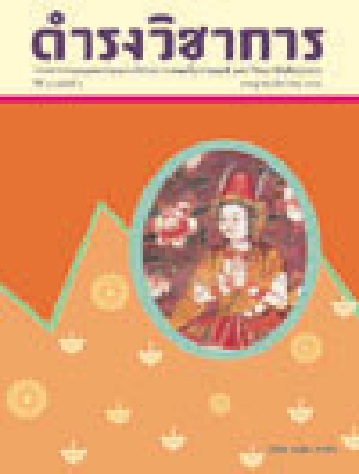CULTUTRAL CAPITAL OF THE THAI SONG DAM AND TRANSFORMATION OF THE COMMUNITY
Keywords:
ทุนวัฒนธรรม, กลุ่มชาติพันธุ์, ไทยทรงดำAbstract
This article is a part of the study entitled “Cultural Capital and Thai Song Dam Ethnic Group’s Development in Nakhon Pathom Province”. The focus of the study was on the inheritance of Thai Song Dam Community’s cultural capital through chronological transformation, starting from the early period of immigration into the study area. According to the field survey conducted in the four villages, namely Ban Ko Rat, Ba Phai Hu Chang, Ban Don Khamin and Ban Laem Kachao 2, it was found that the economic, social and cultural factors in the chronological contexts resulted in adaptations and changes to the Community’s cultural capital in two different aspects. That is, a higher level of adaptation and change was identified in the rice culture, the consumer culture, the dwelling culture, the clothing culture and the linguistic culture among the new generation. On the other hand, culture related to ancestral spirits, families and kinships, worldviews and attitudes, and language underwent a lower level of adaptations and change among the older generation. Therefore, the latter generation continues to outstandingly represent their ethnic identity up to the present time, and is regarded as the Community’s strong cultural capital that has enhanced value, power and happiness for further chronological transformation.
References
จักรแก้ว นามเมือง. ทุนทางวัฒนธรรม. ใน หนังสือวัฒนธรรมไทย. กรุงเทพฯ: ห้างหุ้นส่วนจําากัด นวสาส์นการพิมพ์. 2551.
ชนิดา เสงี่ยมไพศาลสุข. เศรษฐกิจของทรัพย์สินเชิงสัญลักษณ์. กรุงเทพฯ: สําานักพิมพ์โครงการจัดพิมพ์คบไฟ. 2550.
ดิเรก ปัทมสิริวัฒน์. “ทุนทางวัฒนธรรมและภูมิปัญญากับการสร้างสรรค์คุณค่าและมูลค่าเพิ่มทางเศรษฐกิจและสังคมของประเทศ” จัดโดยสําานักงานคณะกรรมการพัฒนาเศรษฐกิจและสังคมแห่ง ชาติ โรงแรมรามากาเด้น.กรุงเทพฯ, 18 กันยายน 2549.
มหาวิทยาลัยมหาจุฬาลงกรณราชวิทยาลัย. วัฒนธรรมไทย (Thai Culture). กรุงเทพมหานคร: ห้างหุ้นส่วนจําากัด นวสาส์นการพิมพ์. 2551.
เรณู เหมือนจันทร์เชย. การศึกษาอิทธิพลของความเชื่อ ประเพณี และพิธีกรรมของชาวไทยโซ่งที่มีผลต่อการพัฒนาคุณภาพชีวิต: กรณีศึกษาหมู่บ้านแหลมกะเจา 2 ตําบลลําลูกบัว อําเภอดอนตูม จังหวัดนครปฐม. วิทยานิพนธ์ศิลปศาสตรมหาบัณฑิต สาขาวิชาพัฒนาชนบทศึกษา, บัณฑิตวิทยาลัย มหาวิทยาลัยมหิดล. 2541.
เรณู เหมือนจันทร์เชย. โลกทัศน์ของกลุ่มชาติพันธุ์ในประเทศไทย: ความเชื่อเรื่องผีของไทยโซ่ง. กรุงเทพฯ: บริษัทสหธรรมมิก จํากัด. 2542.
สุริชัย หวันแก้ว. สังคมและวัฒนธรรม: การเปลี่ยนแปลงทางสังคมและวัฒนธรรม. พิมพ์ครั้ง ที่ 4. กรุงเทพฯ: จุฬาลงกรณมหาวิทยาลัย. 2537.
อคิน รพีพัฒน์, ม.ร.ว. วัฒนธรรมคือความหมาย: ทฤษฏีและวิธีการของคลิฟฟอร์ค เกียร์ซ. กรุงเทพฯ: ศูนย์มานุษยวิทยาสิรินธร (องค์การมหาชน). 2551.
อมรา พงศาพิชญ์. วัฒนธรรม ศาสนา และชาติพันธุ์: วิเคราะห์สังคมไทยแนวมานุษยวิทยา. พิมพ์ครั้งที่ 3. กรุงเทพมหานคร: โรงพิมพ์จุฬาลงกรณมหาวิทยาลัย. 2537.
เอี่ยม ทองดี. ควาย ข้าว พระ ผี พิธีกรรม. กรุงเทพมหานคร: โรงพิมพ์สหธรรมิก. 2547.
เอี่ยม ทองดี. “อันเนื่องด้วยวัฒนธรรม”. วารสารวัฒนธรรมปริทรรศน์. 1, 1 (เมษายน–มิถุนายน 2548): 16–29.
เอี่ยม ทองดี. “การเปลี่ยนแปลงทางวัฒนธรรม”. วารสารวัฒนธรรมปริทรรศน์. 1, 2-3 (กรกฎาคม-กันยายน, ตุลาคม-ธันวาคม 2548): 32-46.
Bourdier, Pierre. Outline of a Theory of Practice. Cambridge: Cambridge University Press, 1997.
E.Adamson Hoebel. Anthropology: The Study of Man. Third edition. New York: McGraw-Hill Book Company. 1949.
Downloads
Issue
Section
License
บทความนี้เป็นผลงานของข้าพเจ้าแต่เพียงผู้เดียว และ/หรือเป็นผลงานของข้าพเจ้าและผู้ร่วมงาน ตามชื่อที่ระบุในบทความจริง และเป็นผลงานที่มิได้ถูกนำเสนอหรือตีพิมพ์ที่ใดมาก่อน




